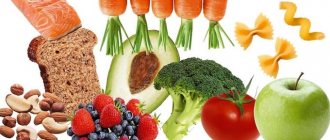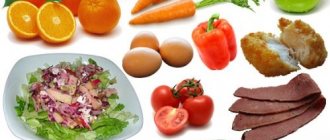Overeating is the main reason for weight gain. To be slim and healthy, the amount of food per day should be no more than that required for physiological processes in the body.
The uncontrolled process of eating food occurs:
- while watching an interesting TV show
- when a person gets worried
- during stress
- in case of non-compliance with the daily routine and diet
- if your metabolism is disturbed
The process of eating must necessarily be conscious.
In order not to overeat, it is enough to put food on the plate in a certain amount, which is determined simply: by your own hands.
Each person's hand size is different. It happens that a slender and fragile woman has large hands, which means, as they say, she has a “rectum”, her body requires an increased amount of food and she can eat plenty, but... no more than the volume that fits in her hands .
There is a large man with small hands. This means that he needs to reduce the amount of food so as not to gain weight and always be in shape.
Nature never makes mistakes and in the body of any person everything is interconnected and organically arranged. You just need to learn to listen to it (nature) and follow its instructions.
How much should you eat per day
How much should you eat per day to lose weight?
The amount of food per day has its own norm and it is advisable not to exceed it:
- Place two palms together like a boat. This amount of food is your norm for breakfast
- for snacks, the amount of food should not exceed the open palm of one hand
- for lunch, as well as for breakfast, the amount is determined by the folded palms of both hands
- for dinner - no more than the fist of one hand.
It’s not for nothing that they say: “Eat breakfast yourself and give dinner to the enemy.”
Like in that Soviet cartoon about a monkey, a parrot and a snake... Let's calculate how much you need to eat per day in "parrots" (in 2 palms): two palms for breakfast and lunch, 1 palm for 2 snacks, it turns out 1 more time two palms and for dinner a quarter of two palms. The total is: 3.25 two palms.
Again, as in the cartoon, re-envision for yourself “parrots into snakes”, that is: measure the volume of two palms on some plate (with a blue border) and then your daily diet will be equal to 3.25 times a plate with a blue border.
What changes occur in the human body with age?
Every decade of our life is associated with a decrease in physical activity, metabolism gradually slows down, although the diet usually not only does not change for the better, but rather worsens. It is after 30-40 years that we cannot deny ourselves an extra portion, especially sweets.
The rate of metabolic processes changes following changes in hormonal levels, which are distinguished by the presence of three crisis milestones:
- 300
More details - 222
More details
- 540
More details
- 1104 984
More details
- Upon reaching the age of 25
, when the production of somatotropin decreases, which allows excess nutrition to be transferred into muscle mass, the growth of the skeletal-articular structure and skin. - Reaching 35-36 years
, when sex hormones are produced in smaller quantities, testosterone levels decrease, and the balance of sex hormones changes. This is the period of midlife crisis. - Overcoming the milestone of 40-45 years
- the level of male testosterone drops even more, many women begin menopause. This provokes a further slowdown in metabolic processes.
How much should you eat to lose weight
For those losing weight, the process of calculating calories is quite labor-intensive and, in the end, either there is not enough time for it or it gets boring counting calories all the time when you want to eat immediately and a lot...
How much should you eat to lose weight, without counting calories each time? It’s enough just to remember a few simple techniques for determining the amount of carbohydrates, proteins, fats, fruits and vegetables.
Now you won’t need to keep counting tables and scales in the kitchen. Only your hands will be needed.
Your hands are always with you and therefore it is very convenient to quickly navigate the amount of products that you put on your plate, without resorting to additional means and saving time.
Daily fat intake
As you know, fats are of plant and animal origin. All fats have high energy value, which means they have high calorie content. When broken down, one gram of fat releases as much as 9.3 kcal (usually rounded to the nearest 9 grams). These calories in the body can be stored as fat reserves in the liver, subcutaneous fat, kidneys and other “fat stores”. The accumulation of fat in the body depends not so much on the nutrient itself, but on the excess calories. When more calories come from food than needed, fats from food are sent by the body for storage.
The merits of fats include the following: they improve the taste and quality of food, ensure the absorption of certain minerals from the intestines, they are a source of fat-soluble vitamins: , , , .
Saturated and unsaturated fats - what's the difference?
Fats contain saturated fatty acids, which are found in animal and poultry fats, as well as unsaturated fatty acids, which predominate in most vegetable oils. Polyunsaturated fatty acids determine the human body’s adaptation to unfavorable environmental factors; they also regulate metabolism in the body, in particular cholesterol.
Excess fats, which are rich in saturated fatty acids, provoke indigestion, lead to poor absorption of proteins, and also contribute to the development of obesity, diabetes, cardiovascular and other diseases.
Saturated fats themselves are necessary for our body. It is with their participation that the most important sex hormones are synthesized - testosterone in men, estrogen and progesterone in women. However, their number must be controlled.
Functions of fats in the body
In the body, fats perform many important functions: energy, construction, protective, transport, heat insulation, they contribute to the dissolution of a number of vitamins.
I would also like to draw attention to the following circumstance. Muscle tissue is “metabolically active” because it participates in the body’s vital processes. And adipose tissue, “metabolically inactive,” is a reserve of energy that will be required as needed. It follows that having muscle mass helps you burn a significant amount of calories throughout the day. At the same time, muscles are much denser than fat, so they take up less space.
Daily fat requirement
Fat requirements are calculated based on each person's actual weight and range from 0.7 to 2 g per kilogram of body weight. Use the Body Parameters Analyzer to navigate further calculations.
People whose weight is within the normal range need to consume 1-1.1 g of fat for every kilogram of their weight. Thus, your fat requirements in grams will be approximately equal to your weight in kilograms (for example, if you weigh 56 kg, you will need 56 g of fat).
Overweight and obese people need to consume 0.7-0.8 g of fat for every kilogram of their weight.
In a healthy diet, fats should make up 20-30% of the average daily caloric intake. You should not lower your fat levels below normal, as this can be fraught with hormonal imbalances. Many people think that by reducing fat to 0.5 g per kilogram of weight, they will lose weight faster, but this is not so. We get fat not from fat, but from excess calories. Therefore, for comfortable weight loss, it is important to maintain a calorie deficit and BJU balance.
Increases in fat up to 2g may be due to certain medical conditions or dietary protocols, such as the keto diet.
Regardless of what numbers you get, the fat content in your diet should be as follows:
- Polyunsaturated Omega-3 fatty acids (fish oil) – 1.8-3 g (we are not talking about the capsule, but about the content of the substance itself);
- Saturated fats – no more than 1/3 of the total fat;
- Everything else is unsaturated fats, mainly from plant sources.
What foods to look for fats in?
Below we will give a small list of foods that are high in fat, remember them. The number indicates the fat content in grams per 100 grams of product:
- sunflower and olive oil (and most liquid oils) – 100
- butter – 82
- pork (dewlap) – 68
- mayonnaise – 67
- hazelnuts – 67
- cod liver in oil – 66
- Brazil nut – 66
- walnut – 65
- pine nuts – 61
- almonds – 58
- processed cheese – 46
- bacon – 45
- soft cheese – 33
- cheddar – 32
- chocolate – 31
A complete list of products sorted by reduced fat content can be found on this page.
Therefore, we advise you to consume everything in moderation and remember that frying increases the amount of fat many times over.
There are four simple ways to reduce your fat intake:
- Stop frying in oil and use a non-stick frying pan for this;
- In one or two meals, eat lean protein, such as lean fish, chicken fillet, low-fat cottage cheese;
- Remove skin from poultry and trim visible fat from meat before cooking;
- Avoid fast food, sausages and processed foods.
You cannot completely give up fats. Remember that their insufficient intake into the body can cause harm, lead to disruptions in the gastrointestinal tract, nervous system, potency, weaken the immune system, and contribute to the development of atherosclerosis and thrombosis. Well, excess fat leads, first of all, to obesity, to the accumulation of large amounts of cholesterol in the blood, and to memory impairment.
Now you know your fat consumption rate, you know which foods to eat are harmful to your figure. All you have to do is choose healthy foods and follow the rule of moderation.
Author: Zhanna Sh. (especially for Calorizator.ru) Copying this article in whole or in part is prohibited.
Essential Nutrients
Polyunsaturated fatty acids (arachidonic, linoleic and linolenic) are considered essential . These substances are an active part of cell membranes and regulate metabolism, in particular the metabolism of cholesterol, phospholipids, and a number of vitamins. They form tissue hormones, prostaglandins and other biologically active substances in the body, and have a positive effect on the condition of the skin and walls of blood vessels, and fat metabolism in the liver. Arachidonic acid is the most active, but it is found in small amounts directly in food products: it is formed in the body from linoleic acid. Approximately 25 g of sunflower, corn or cottonseed oil provides the daily requirement for linoleic acid. However, it should be remembered that a large number of essential fatty acids are destroyed during heat treatment. A deficiency of these acids is one of the causes of cholesterol metabolism disorders and the development of atherosclerosis.
Visible and hidden fats
Butter, mayonnaise, margarine, sour cream, sunflower oil are just a few examples of foods high in fat , but thanks to which our food becomes tastier, but also higher in calories.
Attention! Margarine is one of the food products containing trans fats . There are serious studies proving the serious harm this food product poses to health.
Some foods such as butter, margarine and sunflower oil are called visible fats.
Fatty substances can also be secretive when it comes to the following foods:
- chips;
- avocado;
- sausage;
- eggs;
- cheeses;
- fatty fish;
- fat meat.
Nutrition for men: energy value of food
Energy value is the calories that are found in a certain product. The amount of energy a person receives after eating depends on the number of calories. Calculating the number of calories for men is quite simple - almost every product package indicates their number. The daily calorie intake for the stronger sex depends on physical activity.
If you need to lose weight, then the number of calories consumed per day should be less than those expended. And if you need to gain weight, then, on the contrary, the calories consumed for men should prevail.
When creating a healthy diet, it is necessary to take into account the presence of vitamins in food, fats, proteins, carbohydrates and nutritional value. A lack of a certain element can cause disturbances in the functioning of the body. This is indicated by improper functioning of internal organs, hair loss, dry skin, etc.
Nutrition for men: products
A man's diet must include meat. It contains a lot of protein, which contributes to the normal functioning and development of the body. Meat helps you think actively, act actively, work productively and cope with stress.
Fish is also important. It contains substances that promote normal heart function and also protect against heart failure. The healthiest fish are herring, mackerel, and salmon. Fatty acids, which are abundant in fish, can maintain male youth. And seafood enhances potency.
A healthy diet for men should also include yogurt, kefir, and low-fat milk. This will help maintain good spirits and also contribute to the normal functioning of the gastrointestinal tract. It is advisable to consume dairy at lunch to curb your appetite, but leave room for dinner.
Vegetables and fruits will help fill the body with vitamins and activate brain activity. You should consume half a kilogram of such products per day.
In addition, the diet must be enriched with zinc. He is responsible for success in love affairs, as well as for male strength. Zinc prevents the development of prostate cancer, promotes active sperm production, and strengthens the immune system. Zinc is found in liver, yolk, oatmeal, beans, nuts, oranges, figs, and grapefruits.










